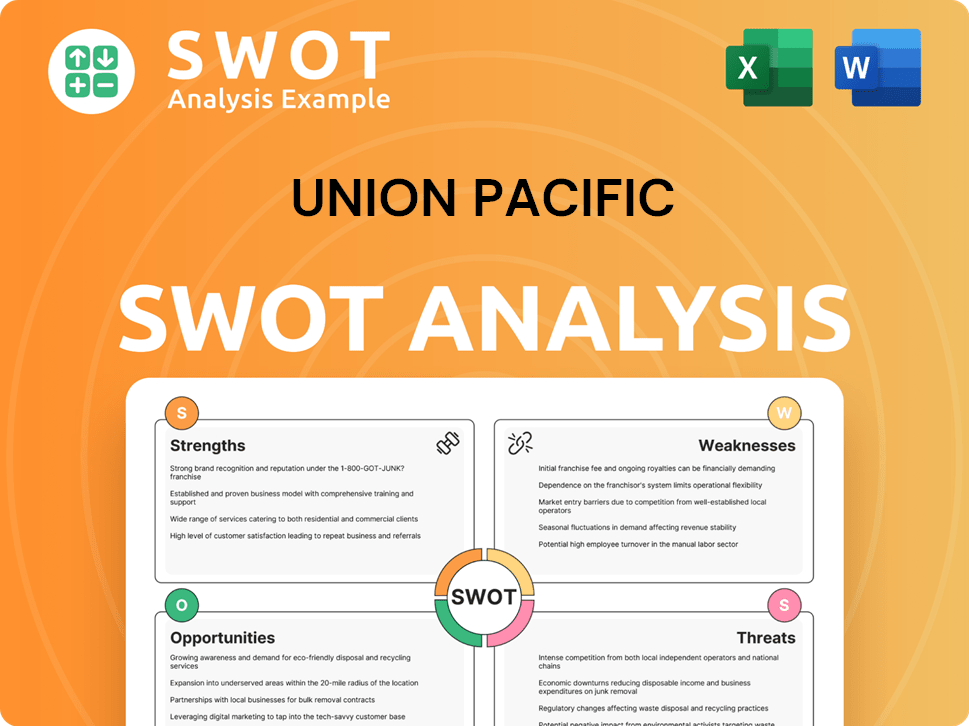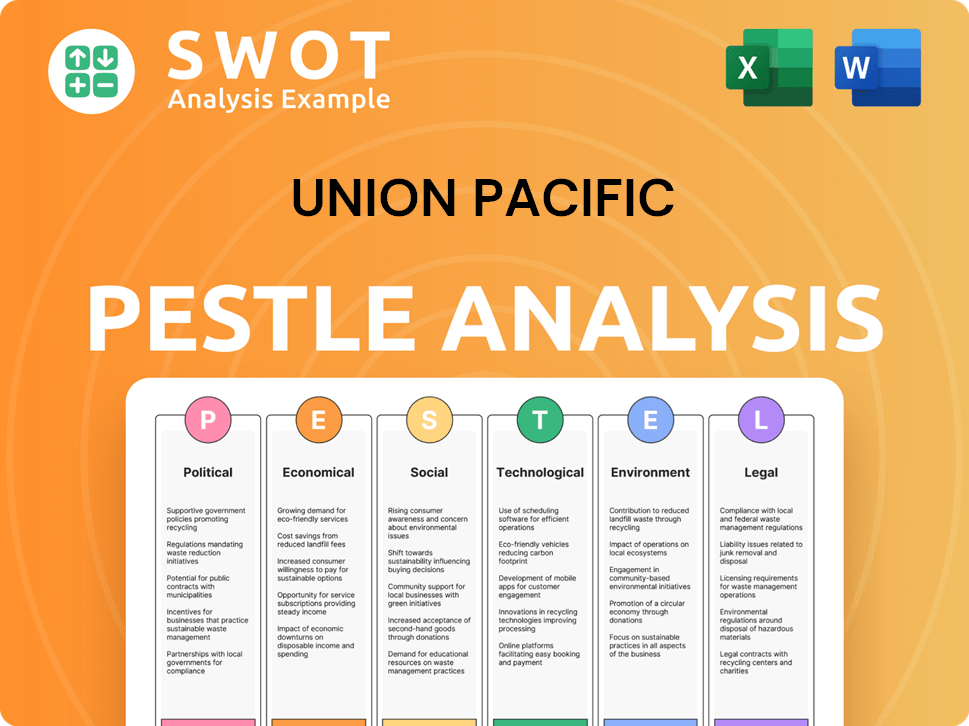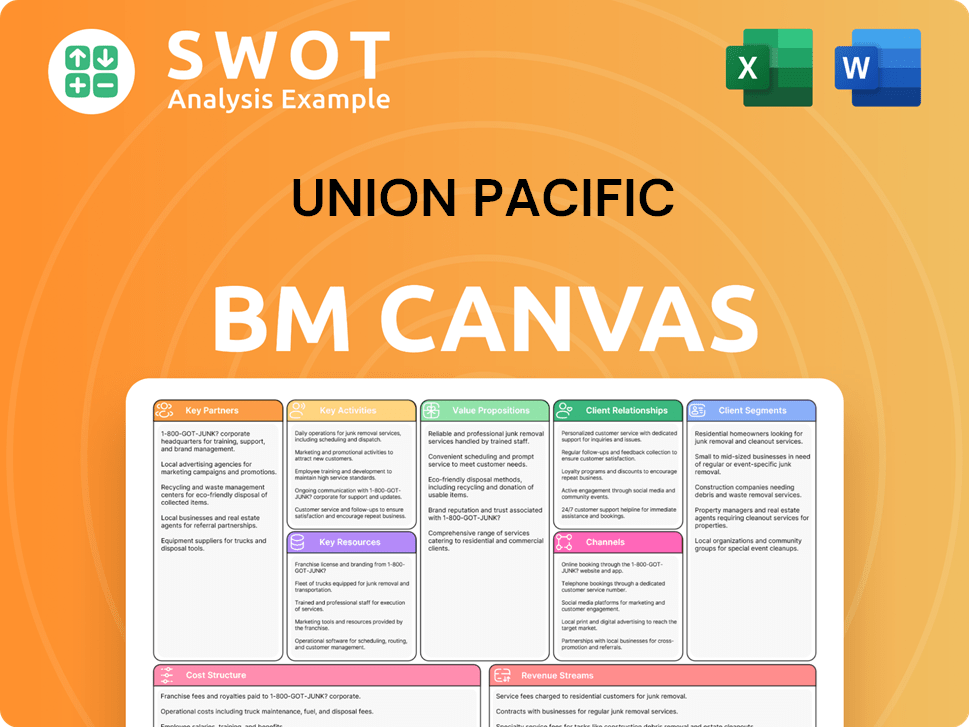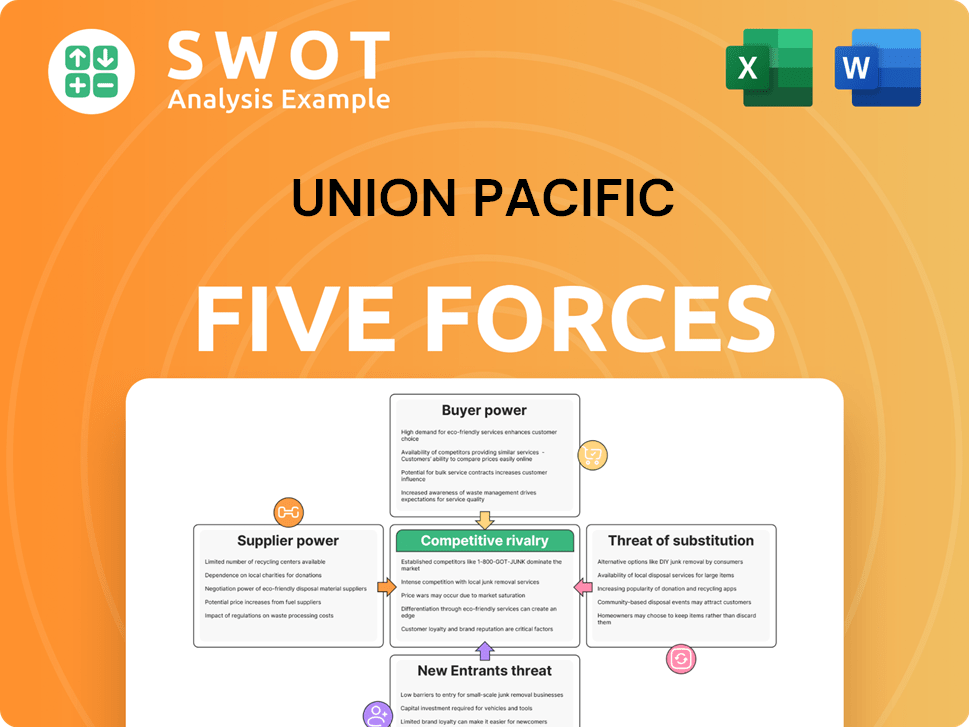Union Pacific Bundle
How did a railroad company shape the destiny of a nation?
Journey back in time to explore the captivating Union Pacific SWOT Analysis. The Union Pacific story is a saga of ambition, innovation, and grit, from its inception during the Civil War to its pivotal role in connecting a divided nation. This monumental project, born from the need for westward expansion, reshaped the American landscape and forever altered the course of transportation and commerce. Discover the fascinating Union Pacific history and its lasting legacy.

Delving into the brief history of Union Pacific Railroad reveals a story of overcoming immense challenges. From its beginnings under the Pacific Railroad Act to its evolution into a modern freight giant, the UP railroad has consistently adapted and innovated. Understanding Union Pacific's founding date and the vision of those who built the Transcontinental railroad provides crucial context for appreciating its current operations and its enduring impact on the American economy. This railroad company continues to be a cornerstone of the North American supply chain.
What is the Union Pacific Founding Story?
The story of the Union Pacific Railroad, a pivotal player in American history, began with a bold vision: to connect the nation from coast to coast. Officially chartered on July 1, 1862, the UP railroad emerged from the Pacific Railroad Act, a landmark piece of legislation signed by President Abraham Lincoln during the Civil War.
This act was a direct response to the urgent need for a transcontinental railroad, recognized as crucial for national defense, westward expansion, and economic integration. While not founded by a single individual, key figures like Grenville M. Dodge and Thomas C. Durant played instrumental roles in shaping the company's early trajectory. Their efforts laid the groundwork for what would become one of the most significant railroad company in the United States.
The primary goal of Union Pacific history was to bridge the vast western territories with a reliable transportation link, connecting the eastern rail networks to the Pacific Coast. This ambitious undertaking promised immense potential for economic growth, resource extraction, and settlement. The initial business model relied heavily on federal land grants and government bonds to finance construction, anticipating revenue from freight and passenger services. The first 'product' was the railroad itself – the tracks, bridges, and rolling stock that would facilitate movement across the continent.
The founding of the Union Pacific was a monumental undertaking, shaped by political will and the drive to unite a nation. The project faced numerous obstacles but ultimately transformed the American landscape.
- The Pacific Railroad Act of 1862 provided the legal and financial framework for the project.
- Key figures like Grenville M. Dodge and Thomas C. Durant were instrumental in the railroad's early operations.
- The initial business model relied on government subsidies and land grants.
- The railroad aimed to connect the East Coast with the West Coast, fostering economic growth.
Union Pacific SWOT Analysis
- Complete SWOT Breakdown
- Fully Customizable
- Editable in Excel & Word
- Professional Formatting
- Investor-Ready Format

What Drove the Early Growth of Union Pacific?
The early growth of the Union Pacific was deeply intertwined with the construction of the Transcontinental Railroad. Beginning in December 1863, the UP railroad embarked on an ambitious westward expansion from Omaha, Nebraska. This initial phase involved extensive logistical coordination and the labor of thousands, including Irish immigrants and Civil War veterans, to lay the initial miles of track.
The most significant milestone in the history of the UP railroad was the completion of the First Transcontinental Railroad on May 10, 1869, when Union Pacific's tracks met those of the Central Pacific Railroad at Promontory Summit, Utah. This event drastically reduced cross-country travel times, revolutionizing American commerce and migration patterns. The Union Pacific's role in the transcontinental railroad was pivotal.
Following the completion of the Transcontinental Railroad, the Union Pacific focused on consolidating its network and expanding into new regions. This involved acquiring smaller railroads and constructing new lines to access growing agricultural and industrial centers. By the late 19th century, the Union Pacific had become a key player in the western rail network, handling a growing volume of commodities, livestock, and passengers.
Leadership transitions and strategic decisions during this period often centered on managing debt, competing with other railroad companies, and navigating economic downturns. The Union Pacific faced immense engineering and financial challenges. Despite these obstacles, the company's early growth was a testament to its ability to shape the economic landscape of the nation.
While specific financial data from the 19th century is limited, it's known that the construction of the Transcontinental Railroad involved massive investments. For instance, the Pacific Railroad Act of 1862 provided significant government funding and land grants to support the project. The Union Pacific's initial capital came from a combination of government bonds and private investments. The company's early locomotives were crucial for transporting materials and workers across the expanding rail network. During the late 1800s, the company's revenue was heavily dependent on freight traffic, particularly agricultural products and raw materials. The early expansion timeline saw the company build and acquire thousands of miles of track, establishing a vast network across the American West.
Union Pacific PESTLE Analysis
- Covers All 6 PESTLE Categories
- No Research Needed – Save Hours of Work
- Built by Experts, Trusted by Consultants
- Instant Download, Ready to Use
- 100% Editable, Fully Customizable

What are the key Milestones in Union Pacific history?
The Union Pacific history is marked by pivotal moments that have shaped its trajectory as a leading railroad company. A key aspect of the brief history of Union Pacific Railroad involves strategic expansions and adaptations to overcome challenges and capitalize on opportunities.
| Year | Milestone |
|---|---|
| 1862 | The Pacific Railroad Act was signed, authorizing the construction of the Transcontinental Railroad, with Union Pacific as a key player. |
| 1869 | Completion of the First Transcontinental Railroad, a landmark achievement that revolutionized transportation and communication. |
| 1996 | Acquisition of Southern Pacific Rail Corporation, significantly expanding Union Pacific's network and operational capabilities. |
Union Pacific has consistently embraced technological advancements to improve efficiency and safety. The company's commitment to innovation has allowed it to adapt and maintain its competitive edge in the transportation sector.
Early adoption of powerful steam locomotives, including the 'Big Boy' locomotives, showcased Union Pacific's commitment to efficiency and capacity. These locomotives were among the largest and most powerful ever built, facilitating the transport of goods across vast distances.
Investment in advanced logistics technologies, such as Positive Train Control (PTC) systems, has enhanced safety and operational efficiency. PTC systems are designed to automatically stop trains if certain safety violations occur, preventing accidents.
Implementation of Precision Scheduled Railroading (PSR) to improve asset utilization and service reliability across its network. PSR focuses on optimizing operations, reducing costs, and improving overall efficiency by streamlining processes.
Throughout its history, Union Pacific has navigated numerous challenges, including economic downturns and regulatory hurdles. The company's ability to adapt through strategic decisions has been crucial to its long-term success.
Economic downturns, such as the Panic of 1873 and the Great Depression, significantly impacted financial stability. These periods required strategic adjustments to maintain operations and ensure long-term viability.
Intense competition from other railroads, trucking, and airlines has shaped operational strategies. Union Pacific has responded by innovating and expanding its services to stay competitive.
In 2023, Union Pacific reported a decrease in operating revenue by 10% to $24.9 billion, primarily due to lower fuel surcharge revenue and decreased volumes. Despite these challenges, the company has maintained its focus on efficiency and strategic investments.
Contending with supply chain disruptions and the need to modernize aging infrastructure has been an ongoing challenge. Union Pacific continues to invest in infrastructure improvements to enhance its network's reliability and capacity.
Strategic divestitures and acquisitions, such as the acquisition of Southern Pacific Rail Corporation in 1996, have expanded its network. These moves have allowed Union Pacific to adapt to changing market conditions and maintain its competitive edge.
The company's ability to adapt to market changes and invest in technology will be critical for future growth. To understand more about the company's position, it's helpful to look at the Target Market of Union Pacific.
Union Pacific Business Model Canvas
- Complete 9-Block Business Model Canvas
- Effortlessly Communicate Your Business Strategy
- Investor-Ready BMC Format
- 100% Editable and Customizable
- Clear and Structured Layout

What is the Timeline of Key Events for Union Pacific?
The Union Pacific has a rich and impactful history deeply intertwined with the development of the United States. From its inception as a key player in the construction of the Transcontinental Railroad to its modern-day operations, the UP railroad has consistently adapted and evolved. The company's journey includes overcoming financial crises, embracing technological advancements, and strategically expanding its network through mergers and acquisitions. These milestones have shaped the Union Pacific history and its significant role in the nation's economic landscape.
| Year | Key Event |
|---|---|
| July 1, 1862 | The Pacific Railroad Act was signed, chartering the Union Pacific Railroad. |
| December 2, 1863 | A groundbreaking ceremony was held in Omaha, Nebraska, marking the start of the Transcontinental Railroad. |
| May 10, 1869 | The Union Pacific and Central Pacific railroads met at Promontory Summit, Utah, completing the First Transcontinental Railroad. |
| 1873 | The company faced financial difficulties during the Panic of 1873. |
| 1897 | Union Pacific emerged from receivership and reorganized its operations. |
| 1941 | The introduction of the 'Big Boy' steam locomotives occurred. |
| 1969 | The company celebrated the 100th anniversary of the Transcontinental Railroad's completion. |
| 1982 | The merger with Missouri Pacific Railroad and Western Pacific Railroad took place. |
| 1996 | The acquisition of Southern Pacific Rail Corporation significantly expanded its network. |
| 2000s | Increased focus on intermodal transportation and technological advancements characterized this period. |
| 2018 | The company implemented the Precision Scheduled Railroading (PSR) operating model. |
| 2023 | Union Pacific reported operating revenue of $24.9 billion. |
| 2024 | The company continues to invest in network improvements and sustainable practices. |
In 2024, the UP railroad plans to invest approximately $3.7 billion in capital expenditures. These investments are targeted towards enhancing network safety, improving capacity, and bolstering overall resilience. This commitment underscores the company's dedication to maintaining and upgrading its infrastructure to meet the demands of a dynamic market and ensure efficient service. These investments are key to the company's long-term growth strategy.
Union Pacific is actively working to reduce its environmental impact. The company has set goals to decrease greenhouse gas emissions and boost fuel efficiency. These initiatives reflect a broader industry trend toward decarbonization and sustainable practices. The company's efforts are in line with its commitment to environmental stewardship and responsible operations, which is becoming increasingly important to stakeholders.
The company anticipates continued growth in intermodal and automotive shipments. While managing the decline in coal volumes, Union Pacific is strategically positioning itself to capitalize on emerging opportunities. The focus on these growth areas indicates a proactive approach to adapting to changing market dynamics and ensuring sustained profitability. The company's diverse portfolio helps to mitigate risks.
Industry trends, such as the rising demand for resilient supply chains, will shape the future strategies of Union Pacific. Leadership is emphasizing operational excellence and delivering value to shareholders. With a forward-looking approach, the company is poised to maintain its relevance and contribute to the economic landscape. The commitment to operational excellence is critical for long-term success.
Union Pacific Porter's Five Forces Analysis
- Covers All 5 Competitive Forces in Detail
- Structured for Consultants, Students, and Founders
- 100% Editable in Microsoft Word & Excel
- Instant Digital Download – Use Immediately
- Compatible with Mac & PC – Fully Unlocked

Related Blogs
- What is Competitive Landscape of Union Pacific Company?
- What is Growth Strategy and Future Prospects of Union Pacific Company?
- How Does Union Pacific Company Work?
- What is Sales and Marketing Strategy of Union Pacific Company?
- What is Brief History of Union Pacific Company?
- Who Owns Union Pacific Company?
- What is Customer Demographics and Target Market of Union Pacific Company?
Disclaimer
All information, articles, and product details provided on this website are for general informational and educational purposes only. We do not claim any ownership over, nor do we intend to infringe upon, any trademarks, copyrights, logos, brand names, or other intellectual property mentioned or depicted on this site. Such intellectual property remains the property of its respective owners, and any references here are made solely for identification or informational purposes, without implying any affiliation, endorsement, or partnership.
We make no representations or warranties, express or implied, regarding the accuracy, completeness, or suitability of any content or products presented. Nothing on this website should be construed as legal, tax, investment, financial, medical, or other professional advice. In addition, no part of this site—including articles or product references—constitutes a solicitation, recommendation, endorsement, advertisement, or offer to buy or sell any securities, franchises, or other financial instruments, particularly in jurisdictions where such activity would be unlawful.
All content is of a general nature and may not address the specific circumstances of any individual or entity. It is not a substitute for professional advice or services. Any actions you take based on the information provided here are strictly at your own risk. You accept full responsibility for any decisions or outcomes arising from your use of this website and agree to release us from any liability in connection with your use of, or reliance upon, the content or products found herein.